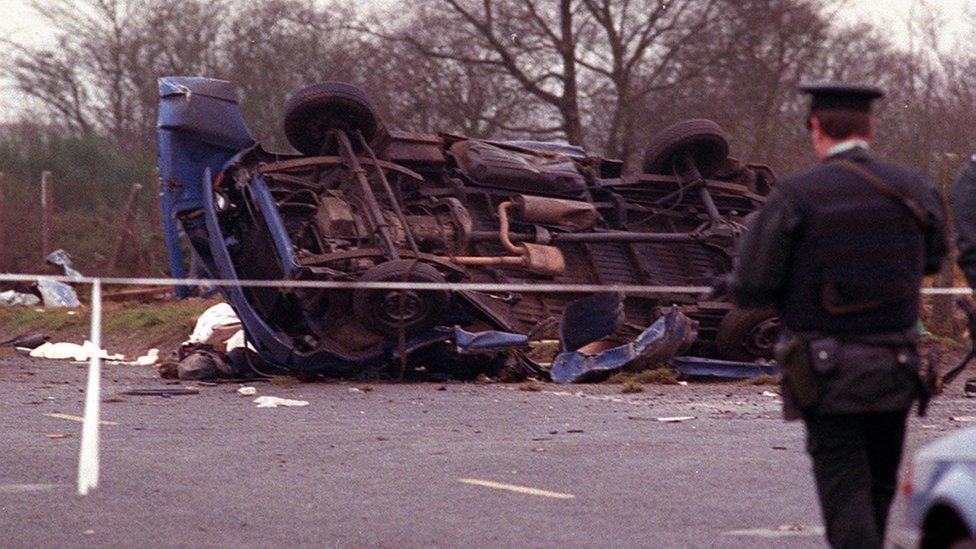NI state papers: Bombs, bullets and bans dominated 1992
- Published

The eight construction workers had left a military base when their van was bombed
The year 1992 began with an upsurge of IRA and loyalist violence in Northern Ireland.
On 17 January, eight Protestant workmen were killed by a massive IRA bomb at Teebane in County Tyrone.
On the same night, the then Secretary of State, Peter Brooke, who was attempting to kick-start a new round of talks, sealed his own political fate.
He was criticised for singing 'My Darling Clementine' on RTÉ's Late Late Show just hours after the bombing.
Mr Brooke was replaced by Sir Patrick Mayhew.
Gun attacks
In February, three people were shot dead in a Sinn Féin office on Belfast's Falls Road by an off-duty Royal Ulster Constabulary (RUC) officer.
The next day, five Catholics were murdered by loyalist gunmen in a bookmaker's shop on the Ormeau Road in the south of the city.

The five people killed in the Ormeau Road gun attack included a 15-year-old boy
A few days later, the SAS shot dead four IRA members who had opened fire on Coalisland RUC station in County Tyrone.
February saw the resignation of Charles Haughey as taoiseach (Irish prime minister) as the result of a phone-tapping scandal.
He was replaced by Albert Reynolds.
The issue of collusion continued to dominate the news and the meetings of the Anglo-Irish Conferences during 1992.
In January, former Ulster Defence Association (UDA) intelligence officer and Army agent, Brian Nelson, external, was convicted of conspiracy to murder.

Brian Nelson (centre) was a former British soldier from the Shankill Road
In March, two Ulster Defence Regiment (UDR) soldiers were convicted of aiding and abetting the Ulster Freedom Fighters (UFF) murder of Loughlin Maginn in 1989.
The 28-year-old Catholic was shot dead at his home near Rathfriland, County Down, and his murder led to the establishment of the Stevens Inquiry, external into allegations of collusion.
In April 1992, a Westminster general election returned a Conservative government under Prime Minister John Major.

John Major was pleased to be back home in 10 Downing Street after winning the 1992 election
The Ulster Unionist Party (UUP) and the Social Democratic and Labour Party emerged as the strongest parties, with 35.5% and 23.5% of the vote, respectively.
The Democratic Unionist Party (DUP) won 13% of the vote while Sinn Féin's share was 10%.
After a dramatic contest, the SDLP's Dr Joe Hendron defeated Sinn Féin leader Gerry Adams in West Belfast.
In April, the UFF generated a wave of revulsion when it murdered Philomena Hanna, a young Catholic 'good Samaritan' in a Belfast pharmacy.

A peace rally was held outside the pharmacy where Philomena Hanna was shot dead
In July, the UDR was merged with the Royal Irish Rangers.
In September, the then UUP leader, James Molyneaux led his party into historic talks in Dublin.
In August, the secretary of state banned the UDA after an upsurge of killings.

This sign appeared in Belfast shortly after the UDA became an illegal organisation
The following month the Provisional IRA carried out a bloody purge of the breakaway.
The year ended with a controversial speech in Coleraine, County Londonderry in which Mr Mayhew said Sinn Féin could be included in future political talks if the IRA ended its campaign.
The Troubles death toll for 1992 was 85.
The newly-release files are available to view at the Public Record Office of Northern Ireland, external (PRONI) in Belfast.